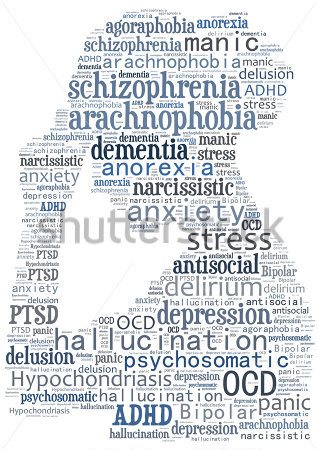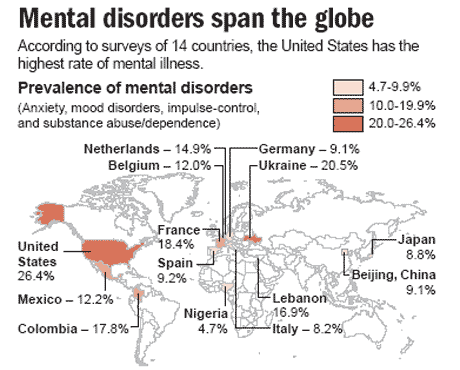
Most Common Types of Mental Health Problems (there are many other conditions not included in this summary)
There are many different conditions that are recognized as mental health disorders.
The more common types include:
- Anxiety disorders: People with anxiety disorders respond to certain objects or situations with fear, as well as with physical signs of anxiety, such as a rapid heartbeat and sweating. An anxiety disorder is diagnosed if the person's response is not appropriate for the situation, if the person cannot manage the response, or if the anxiety interferes with normal functioning.
Anxiety disorders include generalized anxiety disorder, health anxiety disorder, panic disorder, social anxiety disorder, and specific phobias.
- Mood disorders: These disorders, also called affective disorders, involve persistent feelings of sadness or periods of feeling overly happy, or fluctuations from extreme happiness to extreme sadness.
The most common mood disorders are depression, bipolar disorder, and cyclothymic disorder.
- Psychotic disorders: Psychotic disorders involve distorted awareness and thinking. Two of the most common symptoms of psychotic disorders are hallucinations -- the experience of images or sounds that are not present, such as hearing voices -- and delusions, which are fixed beliefs that the person accepts as true, despite evidence to the contrary. Schizophrenia is an example of a psychotic disorder.
- Eating disorders: Eating disorders involve extreme emotions, thoughts, and behaviors involving weight and food.
Anorexia nervosa, bulimia nervosa, and binge eating disorder are the most common eating disorders.
- Addiction disorders: Alcohol and drug are common objects of addictions. Often, people with these disorders become so involved with the objects of their addiction that they begin to ignore responsibilities and relationships.
- Personality disorders: People with personality disorders have inflexible personality traits that are distressing to the person and/or cause problems in work, school, or social relationships. In addition, the person's patterns of thinking and behaviour interfere with the person's daily functioning.
Examples include borderline personality disorder, antisocial personality disorder, obsessive-compulsive personality disorder, and paranoid personality disorder.
-
Obsessive-compulsive disorder (OCD): People with OCD are burduned by constant thoughts or fears that cause them to perform certain rituals or routines. The disturbing thoughts are called obsessions, and the rituals are called compulsions.
An example is a person with an unreasonable fear of germs who constantly washes his or her hands.
-
Post-traumatic stress disorder (PTSD) - Complex PTSD - other trauma-related disorders: PTSD is a condition that can develop following a traumatic and/or terrifying event, such as a sexual or physical assault, the unexpected death of a loved one, or a natural disaster. People with PTSD often have lasting and frightening thoughts and memories of the event.

- Psychoanalysis and psychodynamic therapies:
This approach focuses on changing problematic behaviors, feelings, and thoughts by discovering their unconscious meanings and motivations. Psychoanalytically oriented therapies are characterized by a close working partnership between therapist and patient. Patients learn about themselves by exploring their interactions in the therapeutic relationship. - Behaviour therapy:
This approach focuses on learning's role in developing both normal and abnormal behaviors (classical conditioning: association of two stimuli, desensitizing: repeated exposure to feared stimuli, operant conditioning: rewards and punishments) - Cognitive therapy
This approach emphasizes what people think rather than what they do. Cognitive therapists believe that it's dysfunctional thinking that leads to dysfunctional emotions or behaviors. By changing their thoughts, people can change how they feel and what they do. - Humanistic therapy
Three types of humanistic therapy are especially influential.
Client-centered therapy rejects the idea of therapists as authorities on their clients' inner experiences. Instead, therapists help clients change by emphasizing their concern, care and interest.
Gestalt therapy emphasizes what it calls "organismic holism," the importance of being aware of the here and now and accepting responsibility for yourself.
Existential therapy focuses on free will, self-determination and the search for meaning - Integrative or holistic therapy
Many therapists don't tie themselves to any one approach. Instead, they blend elements from different approaches and tailor their treatment according to each client's needs
Brainstation’s approach is mainly Cognitive Behavioural Therapy (CBT)- a scientific, evidence-based, and highly successful approach: For more information about CBT click here
Brainstation also uses Schema-Focused CBT Therapy for personality disorders and chronic disorders: For more information about Schema Therapy click here
